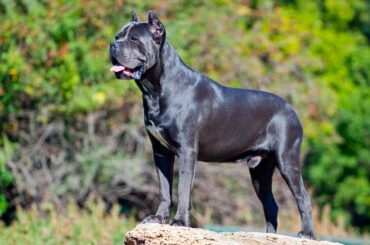The Scottish deerhound is a Scottish breed that dates back to the 16th century. The breed is thought to have existed before the 16th century, but it was known by a number of names. The Scottish Deerhound is a huge hound that was historically developed for coursing red deer. The Deerhound is a huge hound that was historically developed for coursing red deer.

The Deerhound is closely linked to the Irish Wolfhound, and it helped to resurrect that breed at the end of the nineteenth century. When coursing deer, a single Deerhound or a pair was brought as close to the red deer as possible before being released to run one of them down by speed, which if effective would happen within a few minutes.
With the end of Scotland’s clan structures, these hunting dogs became sports animals for landowners and the nobles, although they were also kept and hunted by ordinary people when possible. They were highly valued by aristocracy and poachers alike as fast and silent hunters who could take down any wildlife the size of a hare or greater. One of the breed’s most perilous periods appears to have occurred near the end of the nineteenth century when many major Scottish estates were divided into small estates for sports purposes, and few people kept Deerhounds.
However, the breed suffered as a result of its limited ownership, and it came dangerously close to extinction several times, the most recent time being in 1745 when Scotland’s clan structure disintegrated following the disastrous battle of Culloden during the Jacobite rebellion against English control. The breed was in bad shape by 1769. Archibald and Duncan McNeill attempted to restore the breed to its former glory in the 1820s.
The breed also made its way to America. Bonnie Robin was the first Scottish Deerhound registered by the American Kennel Club in 1886. The breed suffered a further drop in numbers during World War I, when many major estates in Scotland and England were broken up.
The Scottish deerhound arrived in the United States around the end of the nineteenth century, and in 1886, it was accepted into the American Kennel Club (AKC) Hound group. The deerhound is still a reasonably rare and valuable breed today.
Table of Contents
Physical Appearance

The Deerhound is closely linked to the Irish wolfhound and contributed to its development at the end of the nineteenth century. The Scottish Deerhound has a rough coat similar to that of a greyhound. However, it is greater in size and bone. The head is long, the skull is flat, and the muzzle is tapered. Dark, dark brown, or hazel eyes are the most common.
A level, complete scissor bite should be formed by the teeth. The long, hair-covered straight or curved tail should almost reach the ground. Long coat and mane, softer beard and mustache, and softer breast and belly hair. It has little, dark “rose” ears that are soft and fold back against the skull unless it is excited and held semi-erect.
The chilly, frequently damp, and mountainous Scottish Highland glens in which they labored led to the breed’s bigger, rough-coated appearance. Males must be at least 30 inches tall at the withers and weigh between 39 and 50 kilograms; females must be at least 28 inches tall and weigh between 34 and 43 kilograms. With a hard 3–4-inch (7.6–10 cm) height, it is one of the tallest sighthounds. Only self-colored dogs have the rough, wiry coat observed in modern canines. Gray, fawn, or brindle in various tints, but blue-gray is preferable.
Behavior
The Scottish Deerhound is a kind and sociable dog. The breed is known for being docile and willing to please, with a delicate nobility in their demeanor. However, because it is a true sighthound that has been bred for generations to follow the game, most Deerhounds will be keen to chase. Young Scottish Deerhounds can be fairly destructive depending on the individual, especially if they are not given enough exercise; nevertheless, the average adult Deerhound may choose to spend the majority of the day napping on the floor or on a couch.

Training and Caring
They can excel in these venues if their coaches are ready to put in the necessary time and effort. Although Scottish Deerhounds are slower than other breeds when it comes to housetraining, the same patience and perseverance that you used to train your dog can help you with this step. When young, the Deerhound needs a lot of movement to develop properly and maintain its health and condition.
It does not require a large home to live in, but it does require regular access to free exercise in a gated or otherwise “secure” location. Deerhounds should not be raised with only leash walking or a little yard available to them; this would be harmful to their health and growth. When Scottish Deerhounds are young, they require early socialization and exposure to a variety of people, sights, noises, and experiences. The breed sheds at a modest rate, and with frequent brushing, even less. Bathe your deerhound only when required, such as if he has an odor if his coat is soiled.
Health
They’re well-known for being healthful. Cardiomyopathy, osteosarcoma, bloat, stomach or splenic torsion, known as Gastric dilatation volvulus, and cystinuria are among the breed’s major health problems. The average lifespan is 9-11 years.




